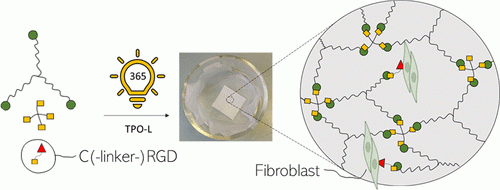
In an attempt to mimic nature’s ability to adhere cells, PCL is often coated with nature-derived polymers or its surface is functionalized with a cell-binding motif. However, said surface modifications are limited to the material’s surface, include multiple steps, and are mediated by harsh conditions. Here, we introduce a single-step strategy toward cell-adhesive polymer networks where thiol-ene chemistry serves a dual purpose. First, alkene-functionalized PCL is crosslinked by means of a multifunctional thiol. Second, by means of a cysteine coupling site, the cell-binding motif C(-linker-)RGD is covalently bound throughout the PCL networks during crosslinking. Moreover, the influence of various linkers (type and length), between the cysteine coupling site and the cell-binding motif RGD, is investigated and the functionalization is assessed by means of static contact angle measurements and X-ray photoelectron spectroscopy. Finally, successful introduction of cell adhesiveness is illustrated for the networks by seeding fibroblasts onto the functionalized PCL networks.
Click here for publisher's page
